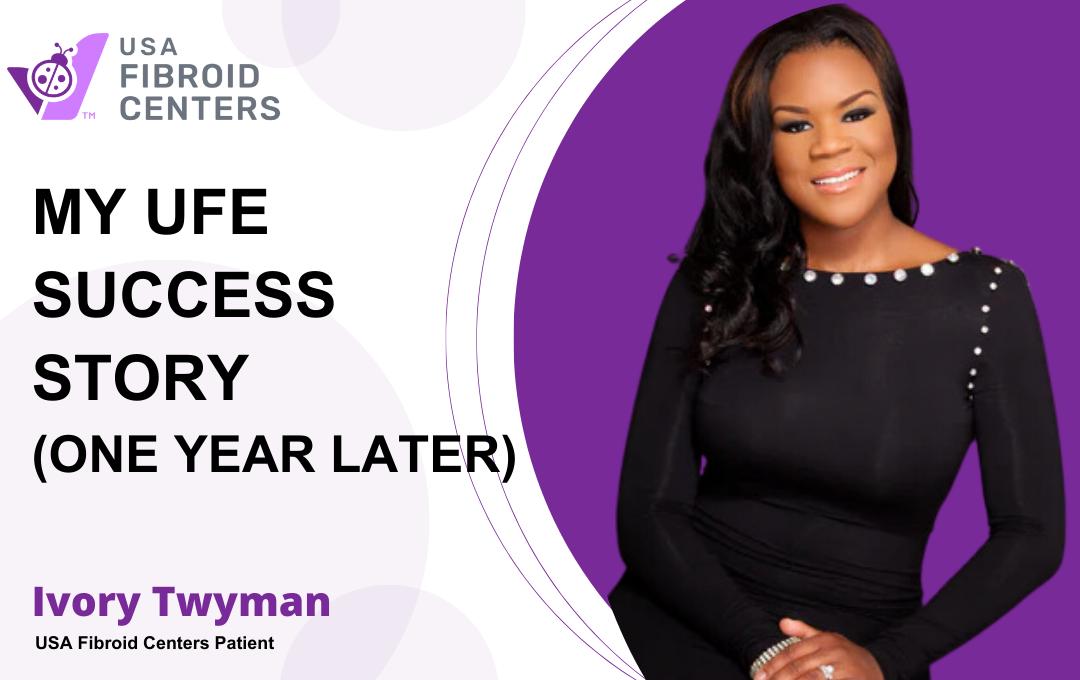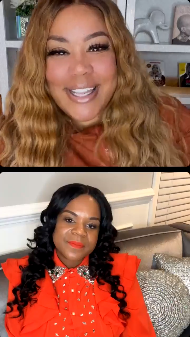
I was awakened in the middle of the night, about two o’clock in the morning, with excruciating pain. And the bed was full of blood,” said Ivory Twyman, who related her experience with fibroids.

One year after UFE, Ivory Twyman, owner of Cloved in Ivy Boutique and a realtor in the Washington D.C. Metropolitan area, shared her fibroid journey and experience with uterine fibroid embolization in USA Fibroids Centers’ ambassador Kym Lee’s Instagram Live, Talk About U.
Twyman underwent uterine fibroid embolization (UFE) with fibroid specialist Dr. Victor Yu, who practices in the Virginia and D.C. areas at USA Fibroid Centers.
“The advice that I would give any woman suffering from fibroids is to make an appointment with USA Fibroid Centers. I’m not a spokesperson, I’m like literally telling you for one reason. My doctors never told me about UFE, to be honest. None of my doctors ever told me about it, right? But at USA Fibroid Centers, they told me about all my options and more regarding UFE.”
Twyman’s fibroids were diagnosed unexpectedly while she was giving birth to her twin sons. Her OB-GYN informed her that he had found eight fibroids, the biggest being the size of a dime. Twyman asked her doctor to take them out, but the doctor informed her that was not the way to go because the fibroids hadn’t bothered her, and she should be fine since they were very small.
Uterine fibroids, benign tumors of the uterus, are prevalent in women of childbearing age. While asymptomatic in many cases, they can cause significant pain, menstrual abnormalities, and fertility challenges. Approximately 80% of women will develop fibroids at some point in their lives. Early detection and management are crucial. Use our symptom checker to assess your risk and seek appropriate medical advice.
2 AM Wake-Up Call: Twyman’s Fibroid Nightmare
Tens of thousands of women are seen annually in the emergency department for the condition, which involves benign growths in the uterus, over a 12-year period. But only one in ten of these visits led to a hospital admission, suggesting that many cases may have been managed in an alternative, non-urgent health setting, according to recent Michigan Medicine research.
Eight years later, Twyman went through a horrific fibroid incident. At 2:00 a.m., she woke up screaming as she found herself bleeding all over the sheets.
“The pain was so severe,” Twyman remembers, “And the bed was full of blood. I felt like it was childbirth, without an epidural. And I could not move.”
Twyman credits seeing Kym Lee’s post about USA Fibroid Centers for saving her life. Her husband picked up the phone and called Kym Lee, who provided a referral to USA Fibroid Centers. Twyman set up a consultation with Dr. Victor Yu.
“When I met with Dr. Yu, he went over all of the different options that a lot of us don’t know that we have. I’m sitting there scared as heck because I’m like, I don’t wanna get a hysterectomy. Although I don’t want any more kids, I didn’t want to go through early menopause and hot flashes, “ said Twyman.
“ I appreciated him going over in great detail so that I could understand myomectomy, hysterectomy, and UFE and all of their differences because that is so important.,” she explained.
Fibroid Surgery: Understand Your Options
During her consultation, Twyman discovered that her fibroids had increased to a total of fifteen fibroids. The largest one was the size of an orange. After weighing her options with Dr. Yu and her gynecologist, Twyman decided that UFE was the right treatment for her.
Fibroid diagnosis and characterization through ultrasound or MRI pave the way for treatment decisions. While small fibroids might not require immediate intervention, treatment becomes a priority for larger ones or those causing significant symptoms.
Women with fibroids are usually given surgical fibroid removal options such as hysterectomy and myomectomy, and hence, most of them have not even heard about UFE.
Signs of Fibroids
Twyman had fibroid symptoms but didn’t realize the cause.
“I remember being at my husband’s job, and I was trying to walk down the hallway to see him, she said. “And I got stopped in my tracks. I could not move because the pain was so severe that it felt that if I moved my uterus or my back, it would rip. I thought it was hemorrhoids, but it was fibroids”.
Fibroids can cause a range of symptoms, including heavy, prolonged periods requiring frequent pad changes, are common. Cramps can be severe and debilitating. Pelvic pressure or bloating in the lower abdomen, is another symptom. Frequent urination, even without fluid intake, can occur as fibroids press on the bladder. For some women, difficulties getting pregnant or miscarriages can be associated with fibroids.
Uterine Fibroid Embolization (UFE) is a Game-Changer
Uterine fibroid embolization (UFE) has come about as a game-changer for women battling fibroids, especially those who wish to get pregnant. Uterine fibroid embolization (UFE) is a minimally invasive image-guided procedure that shrinks fibroids by cutting off their blood supply. Unlike surgery, UFE preserves your uterus and fertility, making it a viable choice for women seeking alternatives to major surgery and lengthy recoveries.
After UFE, your fibroids shrink, and uncomfortable symptoms like heavy periods and chronic pain disappear.
In minimally invasive procedures, like UFE, doctors use a variety of techniques to operate with less damage to the body than with open surgery. In general, UFE is associated with less pain and fewer complications. No hospital stay is required since it is performed in an outpatient setting.
“I was back to work in three days,” reports Twyman. “I had a business to run. It’s really a great thing to be back 100 percent.” Tyman reports that she’s never had a heavy period again.”So now life after UFE, my cycles last maybe about three days.”
How UFE Works

Dr. Yu broke it down for her. With UFE, interventional radiologists use imaging technology to guide a catheter inserted in the groin (femoral artery) or the wrist (radial artery) to the fibroid artery. During treatment, they block the uterine arteries that supply blood to existing fibroids.
Without their blood supply, the fibroids shrink and die, and the body naturally reabsorbs any remaining fibroid tissue.
Watch What is uterine fibroid embolization.
“It was a simple procedure,” Twyman said. “They give you anesthesia. The very next day, I was fine. And for that, I felt like I was having regular cramps, not like fibroid pain.”
Twyman reported that she didn’t even need to take the over-the-counter pain medication she was given. She also never experienced any fibroids being expelled as they were reabsorbed naturally into her body.” I never had a heady period again.” she said. “I would have thought you would have seen gushes or blood or evidence that the fibroids were leaving. There was nothing abnormal.”
Knowing Your Treatment Options
Finding out you have fibroids can be overwhelming, and traditional surgery like hysterectomy or myomectomy is often presented as the only way to manage painful symptoms. Even though surgery for fibroid removal may be a good fit in certain cases, it is not the best choice for everyone. This is where UFE comes in. Uterine fibroid embolization (UFE) is a minimally invasive, non-surgical treatment that can shrink your fibroids and relieve your symptoms without the need for surgery.
“I am so glad I went to Dr. Yu at USA Fibroid Centers when I did. The best part about my consultation was having all my treatment options laid out on the table for me to understand what would work best for me. Previously, I had only been told about surgical fibroid removal procedures. None of my doctors had ever mentioned UFE. This decision saved my life, ” said Twyman.
Just like in Twyman’s case, fibroids can become larger if left untreated, so it’s important to be monitored by your doctor, even if your fibroids aren’t causing symptoms. Fibroids can present a risk of complications during pregnancy, such as miscarriage, preterm birth, or postpartum hemorrhage.
Learn if UFE is Right For You
Find out if UFE is right for you. If you have uterine fibroids and feel like coping with symptoms is taking over your life, it may be time to look into treatment.
Book a consultation at USA Fibroid Centers. Schedule online or call 855.615.2555 to talk with a patient care specialist.




